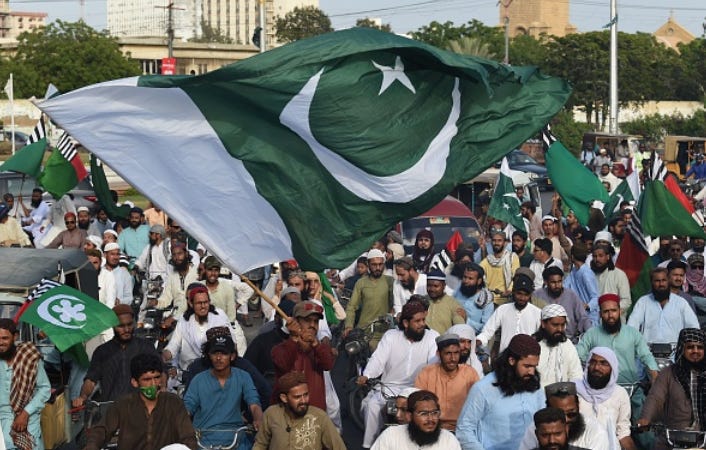Introduction
Pakistan’s military has historically served as a strategic partner for external powers in Afghanistan, notably during the Soviet-Afghan War (via U.S.-backed mujahideen) and post-9/11 operations. Under the Trump administration, which prioritized a reduced U.S. troop presence, Pakistan’s military was pressured to stabilize Afghanistan by combating terrorism or securing borders, potentially in exchange for resumed aid. This *quid pro quo* resembles a mercenary arrangement, where Pakistan’s military leverages its regional influence for financial and political gains. While Pakistan typically uses proxies (e.g., Taliban factions), direct combat roles or intensified proxy support could fulfill U.S. objectives, albeit risking regional blow-back (e.g., retaliatory terrorism).
Internally, Pakistan’s military faces rising populist movements, such as former PM Imran Khan’s PTI, which capitalizes on anti-establishment sentiment. The military’s interference in politics—including Khan’s 2022 ouster and electoral manipulation—has eroded public trust. By suppressing dissent and undermining democratic processes, the military risks galvanizing opposition. Younger, urban populations and marginalized groups (e.g., Pashtuns) increasingly view the army as a self-serving institution that prioritizes foreign agendas over domestic welfare, exacerbating tensions.
The military’s dual focus on external ventures and domestic repression could strain Pakistan’s fragile unity. Here is why:
Resource Diversion: Prioritizing Afghanistan-related operations might divert resources from economic crises, fueling public anger.
Ethnic Separatism: Regions like Balochistan and Khyber Pakhtunkhwa, already resentful of central neglect, could see revived separatist movements (e.g., Baloch insurgency, Pashtun Tahafuz Movement).
Institutional Legitimacy Crisis: If the military is perceived as a U.S. “mercenary” force, nationalist and Islamist groups may rally against it, fracturing the state’s cohesion.
While full Balkanization remains extreme, prolonged military overreach could fragment Pakistan. Weak governance, economic instability, and ethnic grievances might empower regional movements, particularly if the military’s legitimacy collapses. External actors (e.g., India, Iran) or internal rivals could exploit these divisions, mirroring Yugoslavia’s dissolution but contextualized within South Asia’s complex geopolitics.
The U.S. has a history of pragmatic, shifting alliances in South Asia, often prioritizing short-term goals over long-term stability. A potential "double game" could involve tacitly encouraging hostilities between Afghanistan (under Taliban rule) and Pakistan to weaken both adversaries while advancing U.S. interests. This strategy aligns with Washington’s broader aim to counterbalance China’s growing influence (via CPEC) and ensure Pakistan remains tethered to U.S. demands. By leveraging the Taliban’s battle-hardened resilience and Pakistan’s internal vulnerabilities, such a gambit risks destabilizing the region further.
Despite publicly opposing the Taliban, the U.S. could tacitly greenlight limited Taliban cross-border operations (e.g., targeting Pakistani military posts in erstwhile Pashtun territories) to pressure Islamabad into compliance on counterterrorism or geopolitical concessions:
Exploiting Territorial Disputes: Reviving historical Afghan claims over the Durand Line (disputed Afghanistan-Pakistan border) could stoke nationalist tensions, with U.S. diplomacy or intelligence subtly amplifying grievances on both sides.
Economic Leverage: Conditioning aid to Pakistan on aggressive counterterrorism measures in Afghanistan—while turning a blind eye to Taliban reprisals—could trap Islamabad in a cycle of escalation.
Below are reasons why it works against state of Pakistan right now:
Taliban’s Asymmetric Advantage: The Taliban’s decades of guerrilla warfare experience, intimate knowledge of Pashtun terrain, and ideological appeal among border tribes could outmatch Pakistan’s conventional military tactics. Pakistan’s reliance on U.S.-supplied equipment (e.g., F-16s) is less effective in rugged, insurgent-dominated zones.
Domestic Fatigue: Pakistan’s military, already stretched thin by internal counterinsurgency (Balochistan, Khyber Pakhtunkhwa) and economic crises, would struggle to sustain a two-front conflict. Public resentment over rising casualties and inflation could spiral.
Diplomatic Isolation: China, Pakistan’s key ally, may hesitate to intervene directly in an Af-Pak war, fearing blowback on CPEC. Meanwhile, India could exploit the chaos by bolstering anti-Pakistan proxies in Afghanistan (e.g., anti-Taliban factions), deepening Islamabad’s strategic dilemma.
Domestic Fallout and Balkanization Triggers
Anti-Military Backlash: If the public perceives the military as a pawn in America’s double game—fighting a U.S.-instigated war while ignoring civilian suffering—anti-army sentiment would surge. Movements like Pashtun Tahafuz Movement (PTM) and Baloch separatists could gain traction, framing the military as a “colonizing force.”
Ethnic Fracturing: Prolonged conflict with Afghanistan would inflame Pashtun nationalism in Khyber Pakhtunkhwa, where communities straddle the Durand Line. Simultaneously, Sindhi and Baloch separatists might escalate demands for autonomy, citing the state’s diversion of resources to “Punjabi-dominated wars.”
Economic Collapse: War-driven inflation, disrupted trade routes (e.g., via Afghanistan to Central Asia), and diverted military spending could cripple Pakistan’s economy, mirroring Syria or Yemen-like collapse scenarios.
Regional Implications
India and Iran, both wary of a Taliban-Pakistan axis, might exploit the chaos by supporting anti-Pakistan factions in Afghanistan or Balochistan, accelerating Pakistan’s fragmentation.
Beijing could reduce investments in CPEC to avoid entanglement, leaving Pakistan economically stranded.
Conclusion
A U.S.-engineered Af-Pak conflict would compound Pakistan’s existential threats: a militarily overstretched army, economic freefall, and ethnonationalist revolts. While outright Balkanization is not inevitable, the convergence of external manipulation and internal fissures could push Pakistan toward a fractured, warlord-dominated state. The military’s legitimacy—already eroded by political meddling—would collapse if seen as losing a U.S.-proxy war to the Taliban. For Washington, such a strategy risks creating a vacuum for transnational terrorism and great-power rivalry, undermining its own regional goals. Pakistan’s survival hinges on neutralizing external provocations while addressing the root causes of its internal disunity.




